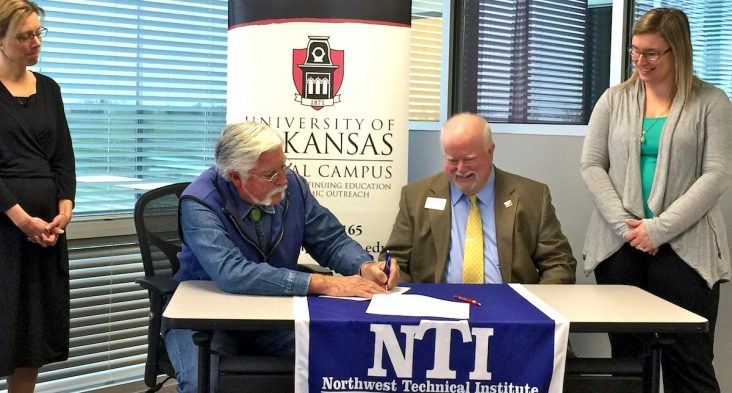NTI, Mid-America Trucking partner with UA to address driver shortages
by January 7, 2016 6:11 pm 700 views

Representatives from Northwest Technical Institute and Mid-America Truck Driving School and the University of Arkansas Global Campus signed an agreement to work together to try and combat the truck driver shortage with recruitment and promotional efforts. (from left) Tara Sprandel, UA Global Campus; Doug Carter, owner of Mid-America Trucking School; Blake Robertson, president of NTI; and Tara Dyer, UA Global Campus.
The top challenge in the commercial trucking industry isn’t regulations. It’s the growing shortage of qualified drivers that is expected to surpass 70,000 this year.
That’s a lot of empty seats in what has become a growing concern since the driver shortage was first reported by the American Trucking Associations in 2005 when the shortfall reached 20,000.
On Thursday (Jan. 7) three strategic partners came together in Rogers to sign an agreement that will allow the Northwest Technical Institute, Mid-America Truck Driving School and the University of Arkansas Global Campus to recruit and promote drivers in a workforce training arrangement.
Doug Carter, owner of Mid-America Trucking, thanked UA Global Campus employees Heather Sprandel and Tara Dyer for reaching out to the driving training schools and trucking industry. Now the two driving schools work together in Springdale training about 9 or 10 new drivers every five weeks. Carter said the driving school is running at roughly 50% capacity and he hopes the attention and promotion from the UA Global Campus will bring more students in the door.
While this is considered a workforce initiative, Blake Robertson, president of NTI, said the partners will share in the training responsibility. He said the first week of training could be held in Rogers at the UA Global Campus, with the hands on driving taking place in Springdale.
“I’m very excited to partner with the UA Global Campus, this puts NTI on a higher plane,” said Robertson, He adds that the group is hopeful this program will make a difference overtime.
Sprandel said the UA Global Campus decided to get involved because it’‘s going to take a big effort to combat the growing driver shortages. She said around 6% of the driver workforce is made up of women, and females comprise 50% or more of the workforce.
“We hope to recruit more women drivers to this industry, but the program is open to everyone,” she said during the press conference. “We think reaching out to women can help fill that gap and it’s a logical place to start.”
The officials did not provide many details about this new initiative, but Sprandel said they hope to work with industry to perhaps sponsor various parts of the initiative such as tuition stipends and other recruitment efforts. Carter said the cost for the five-week driver training program is $3,675. Robertson hopes the industry will become involved and help with those costs when needed. Veterans also are being targeted by carriers and this program as potential drivers because their tuition is often covered by the G.I. Bill.
Lowell-based J.B. Hunt Transport Services, the largest carrier in the region and one of the largest in the country, chronicled the seriousness of driver shortages and retention in a 2014 White Paper. It topped the list of concerns going forward.
“The accumulation of increasing difficulties is substantial enough to begin moving the driver markets in the contract segment. Budgets for recruiting have risen, and driver pay is increasing. Carriers have also reported increased recruiting expense, sign-on bonuses, and mileage pay as they struggle to keep drivers in trucks,” Hunt noted in the White Paper.
Specifically, according to the American Transportation Research Institute (ATRI), 34% of trucking’s operational cost per mile is driver pay, which, with the recent drop in fuel prices, is pushing driver pay as the largest operational cost. And as driver pay increases due to the shortage, it has an impact on fleets. Additionally, as volumes increase, the existing driver pool is only more strained, said ATA chief economist Bob Costello. He said driver pay rose 8% to 10% last year and he expect the same to happen in 2016.
Carter said the shortage has created a bidding war for drivers and it’s also adding to the higher turnover rate.
Costello has said driver turnover in the truckload segment reached 95% last year and is adding to the problem. He said the shortfall is caused by a number of factors. One factor is that the average age of a truck driver is 49, seven years older than the average age of the U.S. worker. This factor means the shortage is likely to worsen before it gets better. He said freight capacity demand is growing, but he’s yet to talk with a carrier that can add capacity. In fact last year, there was a 3% dip in truckload fleet capacity because they could not find drivers to put in the seats.
